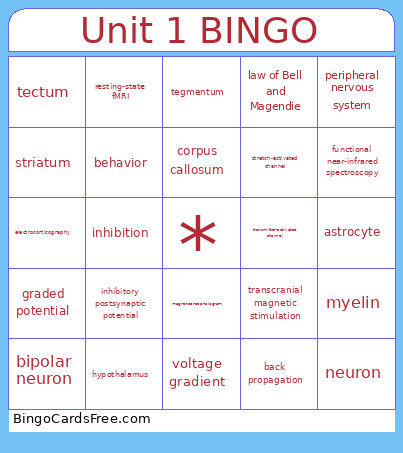Brain Bingo Cards - Print Free or Customize
Print free Brain bingo cards or personalize, unlimited cards! Pick from 20,900+ designs or use our bingo card generator. Add numbers, words, images, or mix them all. Play using printed PDF, online bingo cards, and our online bingo caller, or go hybrid.
About: This bingo card is perfect for a neuroscience class or study group looking for a fun way to reinforce their knowledge. Covering everything from brain anatomy and physiology to key principles and modern imaging techniques, it brings a lively twist to learning complex neuro concepts. Great for students, educators, or neuroscience enthusiasts at events or review sessions.
How To: To save a printable PDF, click the Print button. You can change the card quantity and other printing preferences on the Print tab. Grid items and free space content can be edited on the Basic tab. Appearance can be fully personalized on the relevant tabs, or you can quickly search any option using the 🔍 tab.
How to play Brain Bingo Cards?
- Virtual Players: Click on the Play button above, and then click on the 🎫 button.
- Paper Caller: Print PDF calling list & calling slips and manually choose the slips.
- Paper Players: Print PDF bingo cards and manually mark the cards.
- Virtual Caller: Click on the Play button above.
- Hybrid Play: Select any combination above. For example, caller can be either Printed or Virtual. And players can be Printed or Virtual or a mix of both.
Step-By-Step:
- Start by saving the Brain PDF by clicking on the "Print" button above.
- Open the PDF and print a hard copy.
- For random calling, you can print another copy of the call list, cut, fold and then pick them randomly at play time.
- Cut the bingo cards at the cut lines if there are more than 1 bingo cards per page.
- Give one card to each player. For marking, you can use markers. Crayons are the cheapest.
- Select one person to be the caller. If you are playing in a small group, the caller may as well play along with their own Bingo card.
- The caller begins the game by randomly picking an item from the call list and calling out it to everyone.
- The players check their cards to see if they have the announced word. If they do, they mark that word.
- The first player to finish a horizontal, vertical, or a diagonal line of marked items shouts "Bingo!" and wins the game.
- The caller verifies that the items crossed off form a correct line according to the Bingo card and call list.
- You can play for multiple patterns or a full card blackout for an extended game.
 This Brain Bingo Cards Game contains following Words or Phrases: absolutely refractory, action potential, afferent, allocortex, alpha rhythm, astrocyte, autonomic nervous system, axon, axon collateral, axon hillock, back propagation, basal ganglia, behavior, behavioral neuroscience, bilateral symmetry, bipolar neuron, brainstem, central nervous system, cerebellum, cerebral cortex, cerebral voltammetry, cerebrospinal fluid, cerebrum (forebrain), channel, chordate, compensation, computational neuroscience, computed tomography, concentration gradient, connectome, corpus callosum, cranial nerves, deep brain stimulation, dendrite, dendritic spine, depolarization, dermatome, diencephalon, diffusion, diffusion tensor imaging, efferent, electrical stimulation, electrocorticography, encephalization quotient, enteric nervous system, ependymal cell, epigenetics, equilibrium potential, event-related potential, excitation, excitatory postsynaptic potential, forebrain, frontal lobe, functional magnetic resonance imaging, functional near-infrared spectroscopy, ganglia, gate, genotype, glial cell, graded potential, gray matter, gyrus, hemisphere, hindbrain, hyperpolarization, hypothalamus, inhibition, inhibitory postsynaptic potential, interneuron, law of Bell and Magendie, magnetic resonance imaging, magnetoencephalogram, meninges, microdialysis, microelectrode, microglia, midbrain, motor neuron, myelin, neocortex, Nernst equation, nerve, nerve impulse, nerve net, neural network, neuroethics, neuron, neuronal circuit, neuroplasticity, neuropsychology, node of Ranvier, nucleus, occipital lobe, oligodendroglia, orienting movement, parasympathetic division, parietal lobe, peripheral nervous system, phenotype, phenotypic plasticity, place cells, positron emission tomography, protein, pump, Purkinje cell, pyramidal cell, relatively refractory, resting potential, resting-state fMRI, reticular formation, saltatory conduction, Schwann cell, sensory neuron, soma, somatic nervous system, somatosensory neuron, spatial summation, species-typical behavior, stretch-activated channel, striatum, sulcus, sympathetic division, synapse, tectum, tegmentum, temporal lobe, temporal summation, terminal button, thalamus, threshold potential, tract, transcranial magnetic stimulation, transmitter-activated channel, ventricles, voltage gradient, voltage-activated channel, white matter.
This Brain Bingo Cards Game contains following Words or Phrases: absolutely refractory, action potential, afferent, allocortex, alpha rhythm, astrocyte, autonomic nervous system, axon, axon collateral, axon hillock, back propagation, basal ganglia, behavior, behavioral neuroscience, bilateral symmetry, bipolar neuron, brainstem, central nervous system, cerebellum, cerebral cortex, cerebral voltammetry, cerebrospinal fluid, cerebrum (forebrain), channel, chordate, compensation, computational neuroscience, computed tomography, concentration gradient, connectome, corpus callosum, cranial nerves, deep brain stimulation, dendrite, dendritic spine, depolarization, dermatome, diencephalon, diffusion, diffusion tensor imaging, efferent, electrical stimulation, electrocorticography, encephalization quotient, enteric nervous system, ependymal cell, epigenetics, equilibrium potential, event-related potential, excitation, excitatory postsynaptic potential, forebrain, frontal lobe, functional magnetic resonance imaging, functional near-infrared spectroscopy, ganglia, gate, genotype, glial cell, graded potential, gray matter, gyrus, hemisphere, hindbrain, hyperpolarization, hypothalamus, inhibition, inhibitory postsynaptic potential, interneuron, law of Bell and Magendie, magnetic resonance imaging, magnetoencephalogram, meninges, microdialysis, microelectrode, microglia, midbrain, motor neuron, myelin, neocortex, Nernst equation, nerve, nerve impulse, nerve net, neural network, neuroethics, neuron, neuronal circuit, neuroplasticity, neuropsychology, node of Ranvier, nucleus, occipital lobe, oligodendroglia, orienting movement, parasympathetic division, parietal lobe, peripheral nervous system, phenotype, phenotypic plasticity, place cells, positron emission tomography, protein, pump, Purkinje cell, pyramidal cell, relatively refractory, resting potential, resting-state fMRI, reticular formation, saltatory conduction, Schwann cell, sensory neuron, soma, somatic nervous system, somatosensory neuron, spatial summation, species-typical behavior, stretch-activated channel, striatum, sulcus, sympathetic division, synapse, tectum, tegmentum, temporal lobe, temporal summation, terminal button, thalamus, threshold potential, tract, transcranial magnetic stimulation, transmitter-activated channel, ventricles, voltage gradient, voltage-activated channel, white matter.